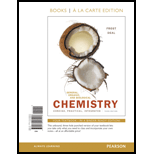
a.
To determine:
The hair spray is solutions, colloids or suspensions.
Introduction:
The solution is the homogenous mixture made up of two or more substances. A colloid is a mixture in which two types of substances are placed together. These substances are called as particle because each substance retains its own properties. They do not settle out of the mixture. The suspension is the type of heterogeneous solution where solid particles do not dissolve in liquid solution.
b.
To determine:
The gasoline is solutions, colloids or suspensions.
Introduction:
The solution is the homogenous mixture made up of two or more substances. A colloid is a mixture in which two types of substances are placed together. These substances are called as particle because each substance retains its own properties. They do not settle out of the mixture. The suspension is the type of heterogeneous solution where solid particles do not dissolve in liquid solution.
c.
To determine:
The hand lotion is solutions, colloids or suspensions.
Introduction:
The solution is the homogenous mixture made up of two or more substances. A colloid is a mixture in which two types of substances are placed together. These substances are called as particle because each substance retains its own properties. They do not settle out of the mixture. The suspension is the type of heterogeneous solution where solid particles do not dissolve in liquid solution.
Want to see the full answer?
Check out a sample textbook solution
Chapter 8 Solutions
GENERAL ORGANIC+BIO...(LL)-W/MOD.ACCESS
- For the reaction: CO2(g) + H2(g) --> CO (g) + H2O (g) Kc= 0.64 at 900 degrees celcius. if initially you start with 1.00 atmoshpere of carbon dioxide and 1 atmoshpere of hydrogen gas, what are the equilibrium partial pressuses of all species.arrow_forwardCan I please get this answered? With the correct number of significant digits.arrow_forwardDraw the Hofmann product of the dehydroiodination of this alkyl iodide. ☐ : + Explanation Check esc F1 2 3 I 88 % 5 F5 I. X © tBuOK Click and drag to sta drawing a structure. © 2025 McGraw Hill LLC. All Rights Reserved. Te BI BB F6 W E R Y S H Karrow_forward
- Chemistry: Matter and ChangeChemistryISBN:9780078746376Author:Dinah Zike, Laurel Dingrando, Nicholas Hainen, Cheryl WistromPublisher:Glencoe/McGraw-Hill School Pub Co
 ChemistryChemistryISBN:9781305957404Author:Steven S. Zumdahl, Susan A. Zumdahl, Donald J. DeCostePublisher:Cengage Learning
ChemistryChemistryISBN:9781305957404Author:Steven S. Zumdahl, Susan A. Zumdahl, Donald J. DeCostePublisher:Cengage Learning Chemistry: An Atoms First ApproachChemistryISBN:9781305079243Author:Steven S. Zumdahl, Susan A. ZumdahlPublisher:Cengage Learning
Chemistry: An Atoms First ApproachChemistryISBN:9781305079243Author:Steven S. Zumdahl, Susan A. ZumdahlPublisher:Cengage Learning 
 Chemistry: The Molecular ScienceChemistryISBN:9781285199047Author:John W. Moore, Conrad L. StanitskiPublisher:Cengage Learning
Chemistry: The Molecular ScienceChemistryISBN:9781285199047Author:John W. Moore, Conrad L. StanitskiPublisher:Cengage Learning Introductory Chemistry: An Active Learning Approa...ChemistryISBN:9781305079250Author:Mark S. Cracolice, Ed PetersPublisher:Cengage Learning
Introductory Chemistry: An Active Learning Approa...ChemistryISBN:9781305079250Author:Mark S. Cracolice, Ed PetersPublisher:Cengage Learning





